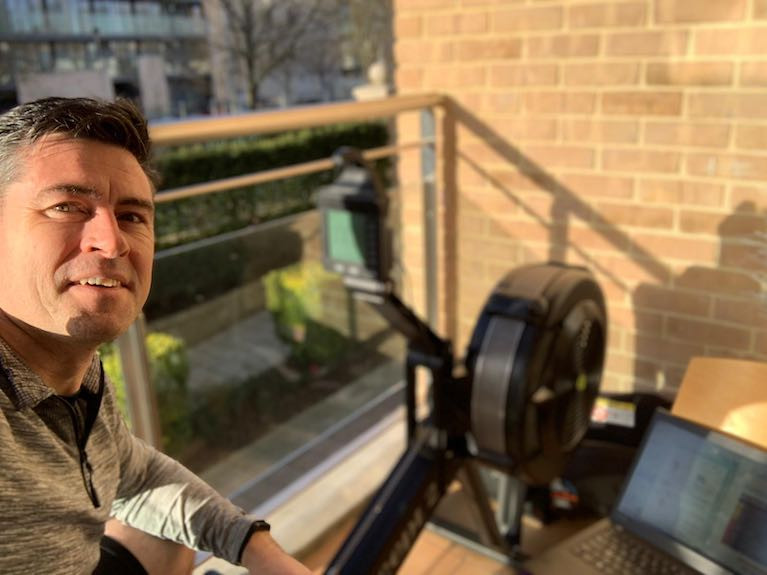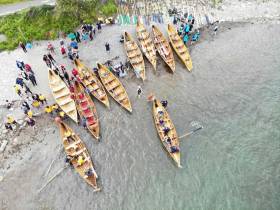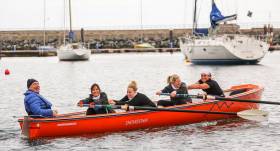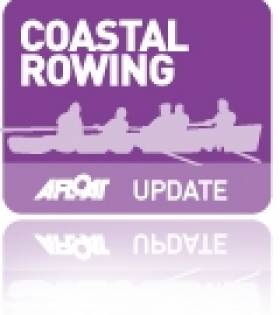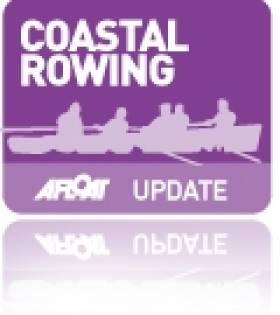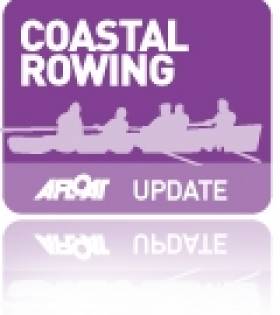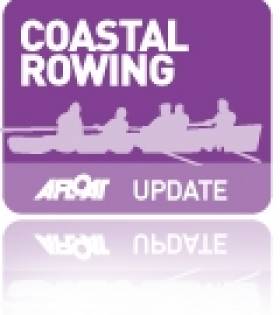Displaying items by tag: St Michael's Rowing Club
East Coast Rowing Clubs Rowed 3,200km and Raised More Than €20,500 for Young Girl’s Cancer Treatment
East Coast rowing clubs pooled their efforts to row more than 3,200km in 24 hours and raise more than €20,500 in aid of a young cancer patient from Blackrock.
As previously reported on Afloat.ie, St Michael’s Rowing Club members spearheaded the challenge to support nine-year-old Alice Hayes, who was diagnosed earlier this year with stage 4 high-risk neuroblastoma, a rare, aggressive, and complex cancer of the nerve cell.
Gareth Witthington and Nicola Fitzgerald of St Michael’s in Dun Laoghaire — who organised the event last Saturday 26 November — hoped to raise €7,500 in the joint effort between all 11 rowing clubs on the East Coast, relay rowing on ergometers to hit a target of 3,171km in 24 hours.
The final totals far exceeded their expectations, with the total distance rowed at 3,228km and funds raised nearly three times what was targeted.
And the funds will make a significant contribution to the care of Alice, whose family need to raise a total of €550,000 to get her access to life-saving cancer drugs in a clinical trial in New York next year.
 Nine-year-old Alice Hayes added to the rowing total herself with the support of her family at St Michael’s RC on Saturday 26 November
Nine-year-old Alice Hayes added to the rowing total herself with the support of her family at St Michael’s RC on Saturday 26 November
“We are delighted with the superb performances by our membership, the wider East Coast clubs, overseas rowers who joined from the United States, Finland and the United Kingdom, Cormac Devlin TD who showed his support by rowing alongside the St Michael’s, the CBRE Global Work Place Solutions office challenges and a dig out from the Dun Laoghaire Sea Scouts who got us over the line,” Witthington said.
“Congratulations to all! We set ourselves the target of €7,500 and between online and offline fundraising the total currently stands at over €20,500!
“This is an incredible amount of money that will go towards getting Alice the help she needs, and we were so moved that Alice came down to row with us on Saturday for a little while.
“To say we are gobsmacked about how much was raised is an understatement!”
Together, the East Coast rowing clubs said they wish to thank all their members and supporters for uniting for this challenge “and proving once again that there is great strength and generosity in unity”.
The GoFundMe page to support Alice’s care is still accepting donations.
St Michael’s Rowing Club give thanks to the following:
- East Coast Rowing Council
- Stella Maris Rowing Club
- St Patrick’s Rowing Club
- Vartry Rowing Club
- Bray Rowing Club
- Dalkey Rowing Club
- Fingal Rowing Club
- Wicklow Rowing Club
- Skerries Rowing Club
- Greystones Rowing Club
- Supervalu Dun Laoghaire
- UCD
- Monkstown Boxing Club
- CBRE Global Work Place Solutions
- Texaco Newtown Park Avenue
- Sea Scouts Dun Laoghaire
Rowing Clubs Unite for Epic 24-Hour Challenge in Aid of Young Cancer Patient
East Coast rowing clubs are undertaking the challenge of rowing around Ireland in 24 hours on indoor rowing machines in aid of Alice Hayes, a nine-year-old girl from Blackrock who has been diagnosed with neuroblastoma, an aggressive type of cancer.
Alice is a bright, beautiful, and brave young girl whose world was turned on its head in April of this year when she was diagnosed with stage 4 high-risk neuroblastoma.
Neuroblastoma is a rare, aggressive, and complex cancer of the nerve cells. Chances of relapse are high, and it carries low survival rates.
“We’re certain she will beat these odds,” say St Michael’s Rowing Club in Dun Laoghaire, who are leading the initiative, “but she needs our help.”
This marks the first time that all 11 rowing clubs along the East Coast — St. Michael’s, Skerries RC, Fingal RC, Stella Maris RC, St Patrick’s RC, Dalkey RC, Bray RC, Greystones RC, Wicklow RC, Vartry RC and Arklow RC — are undertaking a joint fundraising initiative.

Members of the clubs, their families and friends will attempt to row a total of 3,171km in 24 hours on ergometers. Under the watchful eye of St Michael’s captains Gareth Witthington and Nicola Fitzgerald, the challenge will take place on Saturday 26 November from 10 am. The aim is that each person doing the challenge will row for a 30-minute session, which will see people rowing through the night.
The family needs to raise a total of €550,000 to get Alice access to life-saving cancer drugs in a clinical trial at the Memorial Sloan Kettering (MSK) Cancer Center in New York. The funds need to be raised by this Christmas to ensure that she is enrolled in the next available trial group in early 2023.
Clubs hope to raise at least €7,500 for the great cause, and a GoFundMe page has been set up for donations. If anyone would like to join the challenge and row on one of the ergometers in Dun Laoghaire, email [email protected].
After 55 days at sea, the St Michael’s Rowing Club duo of Kevin O’Farrell and Rob Collins completed their epic journey across the Atlantic earlier this week.
Setting off from southern Portugal in early April in a small craft as part of a four-man crew, alongside Dutch rowers Ralph Tujin and Somon van de Hoek, the Irish pair battled rough seas, technical hitches and physical injuries to arrive in French Guiana 55 days later.
Using just their own strength and the ocean currents, the crew worked in two-hour shifts, day and night, for nearly two months. They had to hunker down in a tiny cabin off the coast of Portugal when they hit a storm with sea swells the size of a house. Then, they were nearly run over by a tanker off the coast of the Canary Islands.
Hard luck hit when they realised they had to repair their boat in the Cape Verde islands as their navigation equipment broke. An unexpected challenge was to battle a four-hour onslaught from a shoal of flying fish in the middle of the Atlantic Ocean.
 Rob Collins (left) and Kevin O’Farrell at sea in their four-person ocean rowing boat
Rob Collins (left) and Kevin O’Farrell at sea in their four-person ocean rowing boat
But it was all worth it as on Monday (30 May), they rowed up the Kourou River to reach their final destination, the small town of Kourou in French Guiana, where they were greeted with fireworks and a few well-deserved beers.
A very warm welcome awaits the ‘Salty Pair’ of Robert and Kevin back in Dun Laoghaire, where fellow St Michael’s members will gather round a pint of choice to hear their stories and be inspired by their adventures.
Robert and Kevin rowed across the Atlantic in aid of Muscular Dystrophy Ireland - inspired by Fionn, who lives with Duchenne’s muscular dystrophy.
A voluntary organisation, Muscular Dystrophy Ireland supports kids like Fionn and their families by providing a wide range of respite and support services all year-round, advocating for their community and educating society about neuromuscular conditions and supporting researchers and clinicians to carry out quality research into neuromuscular conditions.
Donations to Robert and Kevin’s fundraising effort can still be made via iDonate HERE.
Dun Laoghaire Harbour's St. Michael's Rowing Club 'Ergs' Its Way Through the Lockdown
A beautiful quote from 'The Wind in the Willows' says that 'there is nothing half so much worth doing as simply messing about in boats." Does that apply to rowing imaginary boats as well? St. Michael's Rowing Club of Dun Laoghaire Harbour thinks so writes the club's Simone Sav
Rowing on erg machines may seem artificial at times to those of us accustomed to the sharp wintery sea breeze, the team effort and the dynamic of rowing wooden skiffs or off-shore boats on the Irish sea. But, given the current COVID-19 context, this is the most respectful and considerate activity our rowing club, St. Michaels' of Dun Laoghaire, can engage with.
 Caitriona Gallagher and Simone Sav
Caitriona Gallagher and Simone Sav
We are delighted to have had 10 rowers compete in the National Indoor Rowing Championships on Saturday, the 23rd of January 2021. Five women and five men (Aoife Byrne, Catriona Gallagher, Colm Crilly, David Cullen, Gareth Wittington, Ger Ryan, Martin Dowd, Nicola Fitzgerald, Samatha Nagle, Simone Sav) competed in 11 races and won four medals, along with Personal Best results. This is the fifth major competition that our members engage in within the last four months on national and international level (3rd of October, 24th of October, 21st November 2020 - for national competitions and 5th December 2020 for the British Indoor Rowing Competitions), with 11 medals won overall. Special mention to Niall O'Toole and his online training sessions many of us follow on a weekly basis.
 Gareth Whittington and Nicola Fitzgerald
Gareth Whittington and Nicola Fitzgerald
As an amateur rower, it takes courage to compete against established athletes. Those minutes before the start of a race, when one has to find its breath, remember their strategy, and retain their self-confidence are always tough. But we are delighted, that, somehow, we do. Consistently. Stubbornly so.
 Ger Ryan
Ger Ryan
Hilary Lovejoy, Club Chairperson, says: 'Our club, along with many other rowing clubs, has to face the challenge of remaining meaningful to its members when normal activities cannot take place. And with good reason. Staying safe, at home, is a solution recommended by the Government to prevent the spread of COVID-19, which we embrace and uphold. We are delighted that so many of our members signed up for this national competition.'
 Aoife Byrne
Aoife Byrne
'We are a coastal rowing club,' says Gary Byrne, Club Captain. 'In normal circumstances, we would offer winter rowing to our members, which is not possible now, due to the pandemic context. We look forward to being back on the water as allowed by the Government but in the meanwhile, we are delighted with our members' results in the Indoor Championships. Fantastic results and congratulations to all participants.'
 Sam Nagle
Sam Nagle
Besides participating in the Indoor Rowing Championships, St. Michael's RC, Dun Laoghaire, will also get involved in providing training sessions on how to read the weather in Dublin Bay for its members in February.
St Michael’s Rowing Club Dun Laoghaire Hosts Home Skiff Regatta On June Bank Holiday Weekend
This June Bank Holiday weekend, St Michael’s Rowing Club Dun Laoghaire hosted their home regatta, which brought together rowers from the East Coast rowing clubs: Arklow, Greystones, Bray, Dalkey, Wicklow, Fingal, and Stella Maris and St Patrick’s in Dublin.
The first of the 18 races kicked off at 9am with a gold medal win for St Michael’s senior ladies rowing in the Gráinne Mhaol, a boat built by Louis Hunkin of WC Hunkin and Sons, who was a special guest.
The event, which saw 90 crews compete in traditional Irish wooden skiffs, was held at Surfers’ Wharf at Seapoint Beach.
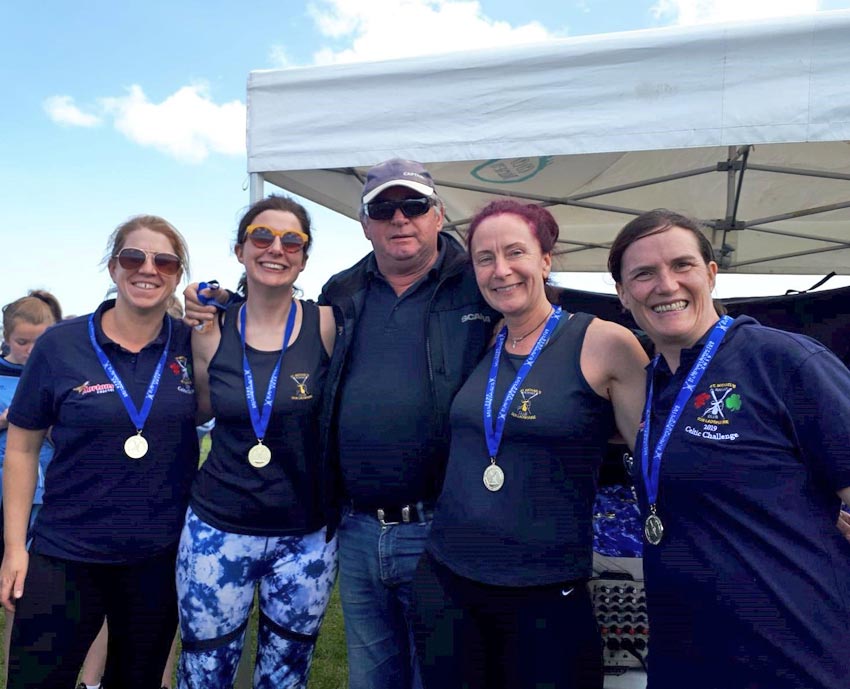 Winning senior ladies Amy Smith, Enya Murray, Liz O’Toole and Nicola Fitzgerald with race sponsor Paul Morton of Morton Coaches | Photo: Mark Rust Fennell
Winning senior ladies Amy Smith, Enya Murray, Liz O’Toole and Nicola Fitzgerald with race sponsor Paul Morton of Morton Coaches | Photo: Mark Rust Fennell
“We selected this area and designed this particular race course in order to ensure that all races can be held within the fairly restrictive window of opportunity imposed by the tidal change, which is approximately five hours,” said Colm Crilly, St Michael’s committee member in charge of race course logistics.
“We are grateful that all clubs have proven very efficient with crew changeovers, as this allowed us to keep a tight schedule.”
Sonja Storm, safety logistics officer on the club committee, added: “An event like this, which brings together hundreds of participants, entails careful planning from the point of view of safety.
“This year, we were glad to welcome Robert Dunne, the designated safety officer of the East Coast Rowing Council, who oversaw this important aspect on the day.”
Jane Collins, organising co-supervisor said: “We would like to thank Dun Laoghaire-Rathdown County Council for their continued support and for allowing us to organise our home regatta every year in this location.”
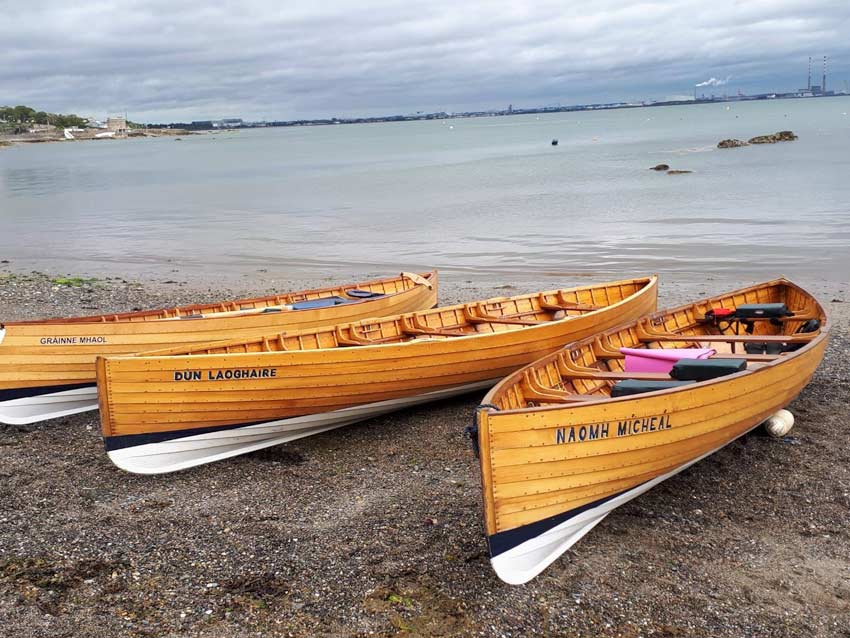 Skiffs on the beach at Surfers’ Wharf | Photo: Mark Rust Fennell
Skiffs on the beach at Surfers’ Wharf | Photo: Mark Rust Fennell
There were 10 adult races (Novice, Intermediate, Junior and Senior Ladies/Men; Mixed; and Vets) catering for a variety of abilities and experience.
Gary Byrne, St Michael’s club captain, said: “It is so encouraging to see a large number of people interested in coastal skiff rowing and racing, from people who just joined to well-seasoned rowers.”
Sarah Lovejoy, club youth officer, who oversaw youth rowing during the regatta said: “Rowing is an all-age sport with many physical and developmental benefits. You work as a team, and you have to tune in and pay attention to what your other team members are doing, because you have to be in sync.”
Rowers as young as 10 competed across a total of eight youth races, divided into four age groups.
The regatta was supported by a number of local businesses and sponsors. “This year, each race had an official sponsor, and we are so grateful for everyone who believes in us and supports us,” said Hilary Lovejoy, organising co-supervisor.
The next event St Michael’s Rowing Club will organise is their very own Hobbler’s Challenge, a 28km long race now open for registration.
“Our club is committed to continuing the tradition of skiff rowing that was passed on by local hobblers. Hosting our annual regatta and organising the Hobbler’s Challenge is a good way of ensuring that we promote this wonderful sport,” said James Tedd, club chairperson.
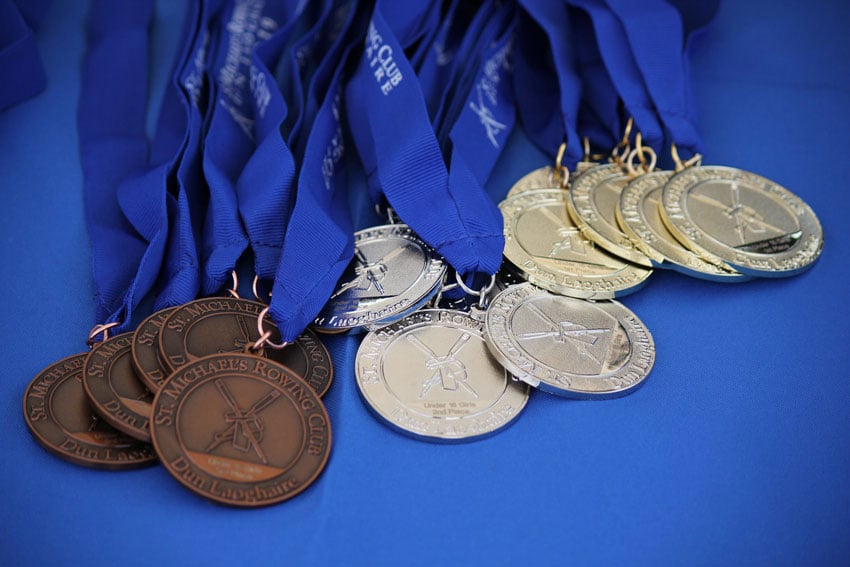 Medals for the day’s winners | Photo: Mark Rust Fennell
Medals for the day’s winners | Photo: Mark Rust Fennell
Irish Flying Fifteen National Champion Chris Doorly is back on the water early this season but before he takes up his usual role at the sharp end of a National Yacht Club keelboat he can be found, as shown in our exclusive photograph above, with a ladies crew from St Michael's Rowing Club in Dun Laoghaire Harbour. Doorly is training for the Celtic Challenge Irish Sea Rowing event which takes place from Arklow to Aberystwyth, Wales this coming Friday.
This test of endurance is 150km and can take 24 hours depending on weather. The club have a mens and womens crew consisting of three teams four who will operate a relay system.
The club are raising funds for both the RNLI and the upkeep of the local clubhouse which featured recently on Afloat.ie
#celticchallenge – During the May bank holiday weekend (2nd-5th May), 12 men and women from of St Michael's Rowing Club, Dun Laoghaire and volunteers from Irish Charity GOAL participated in the biennial rowing race across the Irish Sea known as 'the Celtic Challenge'. What started as a relatively calm sea turned into a tough crossing for the 12 brave men and women and they had to dig deep into their reserves to get over the finishing line, crossing the 150km course in 25hrs, 9 mins, 1 second. The relay race is billed as the longest 'true' rowing race in the world and is listed as such in the Guinness Book of Records.
Due to a good weather system, all the signs had a race start for the Saturday morning. However, the weather deteriorated and the race was given the thumbs up for 2 starts; 3pm and 5pm – on Friday 2nd May – much to the surprise of all participants. St. Michael's Rowing Club were the only crew to enter a traditional east coast skiff, a quarter ton wooden clinker style boat, whilst all other teams opted for the more modern fibreglass, Celtic Longboats. The Celtic Longboats would be much quicker especially in calmer conditions and were soon well on their way.
The format of the race is a relay. Each team has 3 crews of 4 rowers that rotate their time on the oar, resting and refuelling on an accompanying support boat. Generally 'one hour on, two hours off' is the rule of thumb, but conditions, strategies, injuries, and sickness may dictate otherwise. The first 14 hours were fairly calm and certainly much calmer than the conditions met in the previous Celtic Challenge in which more than half of the fleet retired. The choppy and somewhat tricky Arklow Bank was relatively calm too and this time we were past it in under, 2 hours.
As the sun set and darkness grew, the crew knuckled down to what would be seen as a fairly straight forward race across the Irish Sea. Their support yacht, the Emilija and the crew of the rib, the Wizard continued to work tirelessly to ensure the safety of the teams during the changeovers. Both crewed by quite remarkable and extreme professionals, who gave freely of their time to the cause and to whom the club is eternally grateful.
However, as the night went on cloud replaced the clear starry night and visibility became really difficult. We knew the weather was about to take a turn for the worse. Winds rose to around 12 knots which would not usually be seen as a real threat, but the tides and chop made for difficult rowing conditions. Swells along with small, but frequent waves ended any hope for a sub 20 hour finish – a feat that we were well on course for.
Sickness and dehydration were clearly having an effect as 1 hour stints turned out shorter distances. As the daylight came, it was clear the race was going to be another long one. The conditions meant teams hadn't travelled the distance they expected and knew they had to dig deep and work very closely as a unit to ensure spirits were kept high. The changeovers continued and the hours flew by, the crew could see land, and somewhere in the distance was Aberystwyth.
With the sight of the rolling Welsh hills upon the horizon, this gave everybody a massive lift. The rough sea had started to get calmer and this saw us lift average speeds from 2 to over 4 knots and we started to chalk off the nautical miles at an increasing pace. 2-3 miles off Aberystwyth and with the site of the Welsh seaside town in the distance, we were met by a pod of dolphins to welcome us to Wales. About 8-9 bottlenose dolphins started to leap out of the water and were playing games under the bow of the support boat. A fantastic sight that will never be forgotten!
The final changeover was made at around 5.30pm on Saturday, and the pier could be clearly seen with cheering voices being carried on the wind. Fireworks met the crew as they rowed over the finish line. On the slip after the finish, the organisers and other crews were clearly impressed with the 15-year old 'St. Michael' and her brave crew. At the awards ceremony the following day, St. Michael's retained the prestigious 'Spirit of the Celtic Challenge' trophy, which is given to the team which displays the greatest amount of endeavour when completing the course. This was a very proud moment for all the team as well as their friends, family, and all their club mates back home in Dun Laoghaire.
Second time Celtic Challenger and club captain, Nicola Fitzgerald said, "apart from me and 1 other, this crew had only been rowing for a little over 12 months. 5 of the crew representing GOAL had never rowed in an open skiff up until 12 weeks ago! What an achievement for a special bunch of people. They should be proud of themselves".
Camaraderie between the Welsh, Irish and English clubs and teams involved is huge and for the first time ever, the 21 entrants made it across the finishing line. Congratulations are also due to the other Irish teams who crossed the finish line with Wicklow Men's finishing second overall and the first Irish team to cross the line, Arklow Ladies taking the first Ladies Team prize, getting in under 20 hours, Foyle winning the first Mixed crew and strong performances from Ferrycarrig, and Dublin's Airport Fire & Police crews.
St. Michael's teamed up with Irish charity GOAL to participate in the Celtic Challenge to actively seek funds for a support project in the Philippines and a new skiff for St. Michael's Rowing Club.
#celticchallenge – Less than two weeks away from the start of the Celtic Rowing Challenge and a couple of strong contenders for suport boats for a Dun Laoghaire bid on the Irish–Wales race have fallen through.
As Afloat reported earlier, over the May bank holiday weekend (2nd-5th May), St Michael's Rowing Club have teamed up with GOAL to send two crews across the Irish Sea to participate in the biennial 'Celtic Challenge'. The race sets off from Arklow, Co. Wicklow with the finishing line in Aberystwyth, Wales. At 150km, this relay race is billed as the longest 'true' rowing race in the world. Both teams are taking on this challenge to raise funds in aid of the people of the Philippines and a much needed skiff for St. Michael's Rowing Club, Dun Laoghaire.
We urgently need help in finding a support boat for the challenge. The support vessel must not be less than 10m in length. If you have a yacht, licensed angling or dive boat, pleasure cruiser and would be willing to come along for what will be a memorable journey, please get in touch.
"We're stuck at this point and will not be going anywhere unless we get a support boat and fast" Gareth Whittington of St. Michaels told Afloat.ie
If you can help please contact Gareth Whittington on 086 044 7241 or email [email protected]
Get an Oar's Eye View of Coastal Rowing
#Rowing - St Michael's Rowing Club in Dun Laoghaire has posted the above video giving an oar's eye view of one of their regular evening coastal rowing training sessions.
As the description says, the three-and-a-half-minute clip was shot with a miniature GoPro camera attached to the end of an oar which "caught they action from warm-up to interval training to clubhouse".
It's certainly a unique perspective - though maybe not suitable for anyone prone to motion sickness!
Cold Wind, Huge Swells, Blisters, Exhaustion, Elation...The Toughest Celtic Challenge Ever
#COASTAL ROWING – During the May bank holiday weekend (4th-6th May), 12 men and women of St Michael's Rowing Club, Dun Laoghaire, participated in the biennial rowing race across the Irish Sea known as 'the Celtic Challenge'. It turned out to be what is widely regarded as the toughest crossing in the race's 19 year history, with just 12 of the 23 teams entered crossing the finish line unaided. St. Michael's finished 12th in the longest time ever taken for the 150km course – 27hrs, 18 mins, 21 seconds. The relay race is billed as the longest 'true' rowing race in the world and is listed as such in the Guinness Book of Records.
The run up to the event was challenging in itself with the team working tirelessly to secure a replacement support boat due to damage to the mast of the yacht that had already been confirmed. With just two days to departure, all the pieces of the puzzle were in place.
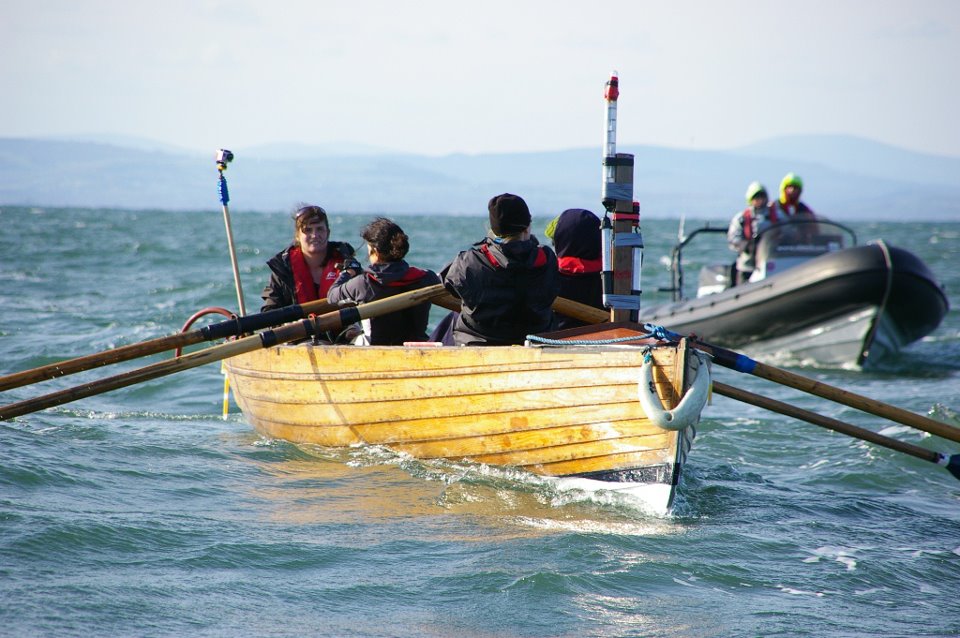
Pushing hard with a safey RIB keeping a watchful eye
Due to poor weather conditions, the race was postponed a number of times and eventually set off from Arklow, Co. Wicklow on Saturday 5th May at 4pm. Very soon after the start, the team from Bray Rowing Club who were rowing the only other traditional east coast skiff in the race had pulled out due to damage to their support boat, meaning that St. Michael's were the only wooden boat left in the race.
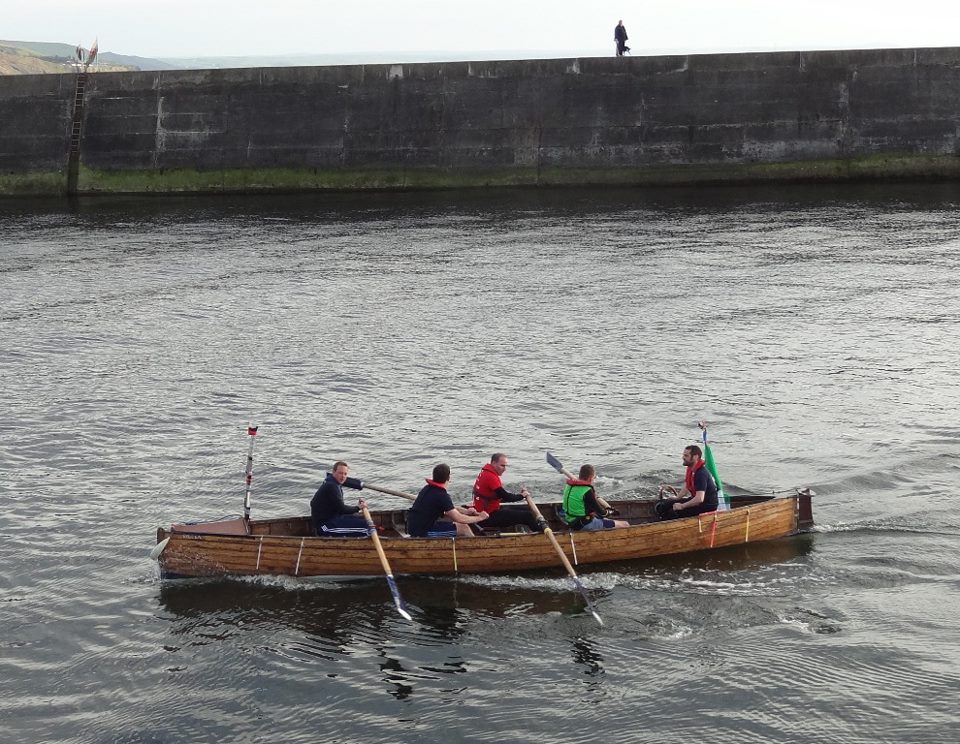
Over the line in Aberystwyth
The format of the race is a relay. Each team has 3 crews of 4 rowers that rotate their time on the oar, resting and refuelling on an accompanying support boat. Generally 'one hour on, two hours off' is the rule of thumb, but conditions, strategies, injuries, and sickness may dictate otherwise. The first 6 hours were the toughest and most challenging physically, as the northeast wind and swells created extremely challenging conditions for the participating rowers. The start was choppy and the Arklow Bank lived up to its reputation of being an extremely tough obstacle, but St. Michaels' quarter-ton clinker built skiff was well suited to the conditions. The solid wood oars used are three times heavier than carbon fibre equivalents used by all other teams, requiring strength and a particular technique even in normal conditions.
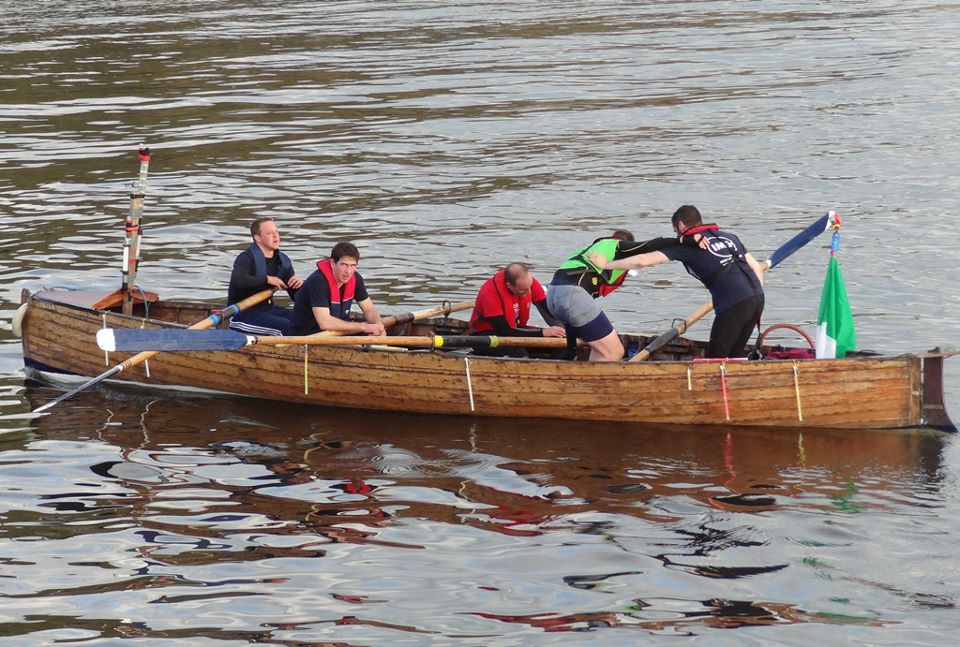
Exhausted but delighted
As the sun set, the crew knuckled down to what would be a tough, night-time row with changes of crew every hour. Their support yacht, the Helcia and the crew of the rib, the Wizard worked tirelessly to ensure the safety of the teams during the changeovers, both crewed by quite remarkable and extreme professionals, who gave freely of their time to the cause and to whom the club is eternally grateful. Working in two to three metre swells made rowing tough, and required 100% concentration and complete focus.
As the sun rose, it was clear the race was going to be a long one. Extreme conditions overnight meant teams hadn't travelled the distance they expected and knew they had to dig deep and work very closely as a unit to ensure spirits were kept high. As the changeovers continued and the hours flew by, the crew could see land, and somewhere in the distance was Aberystwyth. At this point, news of the night's retirements began to filter through on the VHF radio, with tales of other teams forced to pull out or turn back due to reasons including mechanical failure of support boats, sea sickness, damaged boats, lost rudders, and so on.
The final changeover was made at around 6.30pm on Sunday, and the pier could be clearly seen with cheering voices being carried on the wind. On the slip after the finish, the organisers and other crews were clearly impressed with the 30-year old 'Eileen' and her brave crew. At the awards ceremony the following day, St. Michael's became the first Irish team to be awarded the prestigious 'Spirit of the Celtic Challenge' trophy, which is given to the team which displays the greatest amount of endeavour when completing the course. This was a very proud moment for all the team as well as their friends, family, and all their clubmates back home in Dun Laoghaire.
First time Celtic Challenger was Wales born Gareth Whittington, now living in Dun Laoghaire told us, "I was told you never know what to expect as each Celtic Challenge is different because of the changing weather conditions, but I cannot and will not ever forget the way we pulled together as a team to ensure we got to Aberystwyth, an remarkable achievement".
Camaraderie between the Welsh and Irish clubs and teams involved is huge, but the team's thoughts that weekend were with the teams that did not make it, particularly their fellow Irish teams from Bray Rowing Club, Team Marie Keating, Ferrycarrig Rowing Club, and Airport Police and Fire Service Rowing Club. Congratulations are also due to the other Irish teams who crossed the finish line, Courtown, Foyle, and Arklow Rowing Clubs, the latter two of which won their respective categories.
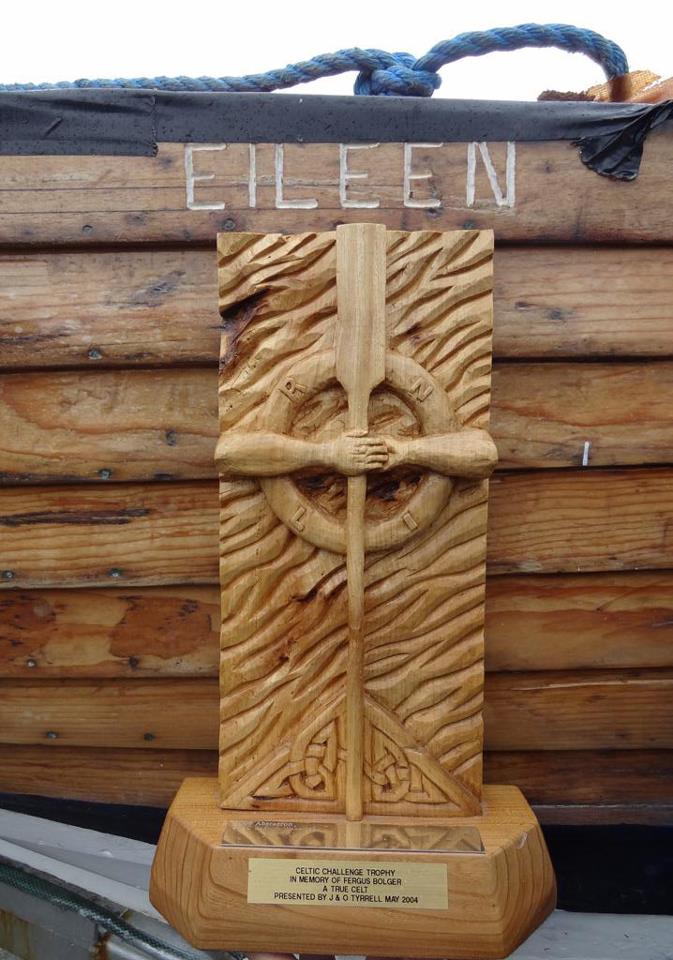
Spirit of the Celtic Challenge Award
St. Michael's participated in the Celtic Challenge to actively seek sponsorship, in a drive to raise funds towards new clubhouse facilities in Dun Laoghaire Harbour. Currently, the club lacks space to store their three wooden boats, space for indoor training, and is without changing facilities for the men, women and children who row for the club. It is hoped that the money raised can be put towards achieving this long-standing goal and keep the club's traditions and the tradition of the Celtic Challenge alive.
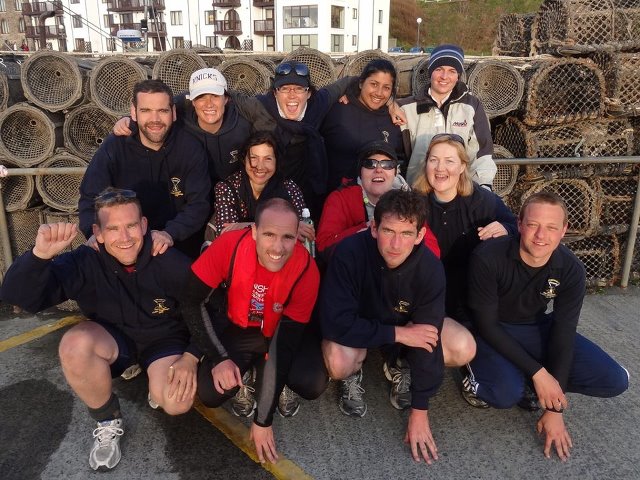
St. Michael's 2012 Celtic Challenge crew


























